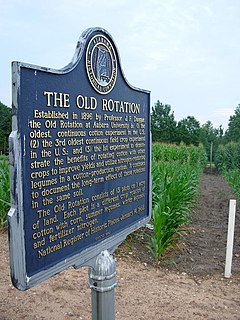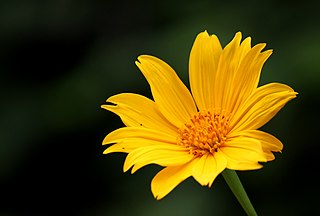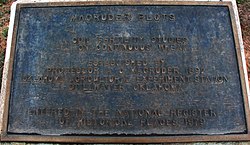
A fertilizer or fertiliser is any material of natural or synthetic origin that is applied to soils or to plant tissues to supply one or more plant nutrients essential to the growth of plants. Many sources of fertilizer exist, both natural and industrially produced.

Agricultural productivity is measured as the ratio of agricultural outputs to agricultural inputs. While individual products are usually measured by weight, their varying densities make measuring overall agricultural output difficult. Therefore, output is usually measured as the market value of final output, which excludes intermediate products such as corn feed used in the meat industry. This output value may be compared to many different types of inputs such as labour and land (yield). These are called partial measures of productivity.

Agronomy is the science and technology of producing and using plants for food, fuel, fiber, and land reclamation. Agronomy has come to encompass work in the areas of plant genetics, plant physiology, meteorology, and soil science. It is the application of a combination of sciences like biology, chemistry, economics, ecology, earth science, and genetics. Agronomists of today are involved with many issues, including producing food, creating healthier food, managing the environmental impact of agriculture, and extracting energy from plants. Agronomists often specialise in areas such as crop rotation, irrigation and drainage, plant breeding, plant physiology, soil classification, soil fertility, weed control, and insect and pest control.
In agriculture, green manure is created by leaving uprooted or sown crop parts to wither on a field so that they serve as a mulch and soil amendment. The plants used for green manure are often cover crops grown primarily for this purpose. Typically, they are ploughed under and incorporated into the soil while green or shortly after flowering. Green manure is commonly associated with organic farming and can play an important role in sustainable annual cropping systems.

A feedlot or feed yard is a type of animal feeding operation (AFO) which is used in intensive animal farming for finishing livestock, notably beef cattle, but also swine, horses, sheep, turkeys, chickens or ducks, prior to slaughter. Large beef feedlots are called concentrated animal feeding operations (CAFO) in the United States and intensive livestock operations (ILOs) or confined feeding operations (CFO) in Canada. They may contain thousands of animals in an array of pens.

Nutrient management is the science and practice directed to link soil, crop, weather, and hydrologic factors with cultural, irrigation, and soil and water conservation practices to achieve optimal nutrient use efficiency, crop yields, crop quality, and economic returns, while reducing off-site transport of nutrients (fertilizer) that may impact the environment. It involves matching a specific field soil, climate, and crop management conditions to rate, source, timing, and place of nutrient application.
In agriculture, crop yield refers to both the measure of the yield of a crop per unit area of land cultivation, and the seed generation of the plant itself. That figure, 1:3, is considered by agronomists as the minimum required to sustain human life.
A long-term experiment is an experimental procedure that runs through a long period of time, in order to test a hypothesis or observe a phenomenon that takes place at an extremely slow rate.

The Cullars Rotation is a soil fertility experiment on the Auburn University campus in Auburn, Alabama and is listed on the National Register of Historic Places. The Cullars Rotation experiment, which started in 1911, is the oldest ongoing cotton fertility experiment in the United States, the oldest soil fertility experiment in the Southern United States, and the second oldest continuous cotton experiment in the world.

The Old Rotation is a soil fertility experiment on the Auburn University campus in Auburn, Alabama. The Old Rotation experiment, which started in 1896, is the third-oldest ongoing field crop experiment in the United States and the oldest continuous cotton experiment in the world. It was the first experiment to show that a cotton/legume crop rotation would allow soil to support a cotton crop indefinitely. The Old Rotation is listed on the National Register of Historic Places.

Drill cuttings are the broken bits of solid material removed from a borehole drilled by rotary, percussion, or auger methods and brought to the surface in the drilling mud. Boreholes drilled in this way include oil or gas wells, water wells, and holes drilled for geotechnical investigations or mineral exploration.

Tithonia diversifolia is a species of flowering plant in the Asteraceae family that is commonly known as the tree marigold, Mexican tournesol, Mexican sunflower, Japanese sunflower or Nitobe chrysanthemum. It is native to Mexico and Central America but has a nearly pantropical distribution as an introduced species. Depending on the area they may be either annual or perennial. It has shown great potential in raising the soil fertility in soils depleted in nutrients. Originating in Mexico; research has shown its potential in benefiting poor African farmers. This plant is a weed that grows quickly and has become an option as an affordable alternative to expensive synthetic fertilizers. It has shown to increase plant yields and the soil nutrients of nitrogen (N), phosphorus (P), and potassium (K).
The Illinois Soil Nitrogen Test ("ISNT") is a method for measuring the amount of Nitrogen in soil that is available for use by plants as a nutrient. The test predicts whether the addition of nitrogen fertilizer to agricultural land will result in increased crop yields.

Paspalum scrobiculatum, commonly called Kodo millet or Koda millet,, is an annual grain that is grown primarily in India, and also in the Philippines, Indonesia, Vietnam, Thailand, and in West Africa from where it originated. It is grown as a minor crop in most of these areas, with the exception of the Deccan plateau in India where it is grown as a major food source. It is a very hardy crop that is drought tolerant and can survive on marginal soils where other crops may not survive, and can supply 450–900 kg of grain per hectare Kodo millet has large potential to provide nourishing food to subsistence farmers in Africa and elsewhere.

Agricultural pollution refers to biotic and abiotic byproducts of farming practices that result in contamination or degradation of the environment and surrounding ecosystems, and/or cause injury to humans and their economic interests. The pollution may come from a variety of sources, ranging from point source water pollution to more diffuse, landscape-level causes, also known as non-point source pollution. Management practices play a crucial role in the amount and impact of these pollutants. Management techniques range from animal management and housing to the spread of pesticides and fertilizers in global agricultural practices.
Phosphate rich organic manure is a type of fertilizer used as an alternative to diammonium phosphate and single super phosphate.

Manure is organic matter, mostly derived from animal feces except in the case of green manure, which can be used as organic fertilizer in agriculture. Manures contribute to the fertility of the soil by adding organic matter and nutrients, such as nitrogen, that are utilised by bacteria, fungi and other organisms in the soil. Higher organisms then feed on the fungi and bacteria in a chain of life that comprises the soil food web.
Abdul Rashid, (Ph.D.), is a Pakistani agricultural scientist and Associate Professor of bioscience, who has served as Member of Biosciences of the Pakistan Atomic Energy Commission (PAEC) from 2008 to 2011.
CULTAN Fertilization, or Controlled Uptake Long Term Ammonium Nutrition, is a type of injection fertilization where the entire amount of nitrogen needed for a plant to grow is injected at one time. During CULTAN fertilization, nitrogen is applied at the first signs of nitrogen deficiency in plants. Fertilizer is more commonly spread on the surface of fields in either a liquid or powder form by spraying it.

Reuse of excreta refers to the safe, beneficial use of animal or human excreta, i.e. faeces and urine. Such beneficial use involves mainly the nutrient, organic matter and energy contained in excreta, rather than the water content. Reuse of excreta can involve using it as soil conditioner or fertilizer in agriculture, gardening, aquaculture or horticultural activities. Excreta can also be used as a fuel source or as a building material.



















